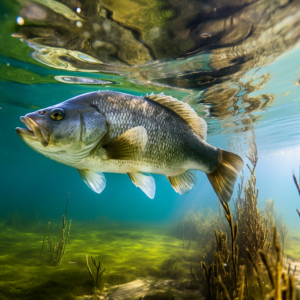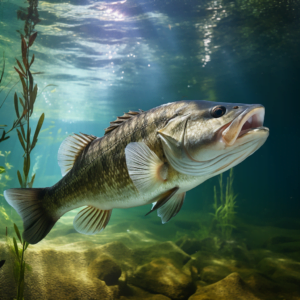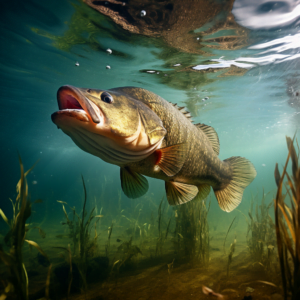So, you’re wondering if it’s safe to eat bass in Texas, huh? Well, let’s dive into the topic and find out. Bass is a popular fish among anglers and seafood lovers alike, and Texas is known for its abundance of bass-filled lakes and rivers. But just because it’s available and delicious, does that mean it’s safe to consume? In this article, we’ll explore the safety of eating bass in Texas and provide you with valuable information to make an informed decision.
First off, bass is generally safe to eat in Texas, as long as you follow a few guidelines. Texas Parks and Wildlife Department advises anglers to be cautious of fish consumption due to potential mercury contamination. While most bass contain low levels of mercury, some larger specimens can accumulate higher levels over time. To minimize any risk, it’s recommended to limit consumption of larger bass, especially for pregnant women, nursing mothers, and young children. The good news is that the TPWD regularly monitors and updates fish consumption advisories, so you can keep yourself informed about which bodies of water and fish sizes are safest to eat.
Furthermore, regulations and guidelines are in place to ensure the safety of the fish you catch. The Texas Department of State Health Services establishes rules and conducts regular inspections of fish markets and restaurants to guarantee that the bass you purchase or consume at a restaurant is safe. They make sure that the fish has been handled and prepared properly, and that it meets the required standards. So, when it comes to enjoying a tasty bass dinner in Texas, you can feel confident that the authorities have taken measures to protect your health and well-being.
In conclusion, bass is generally safe to eat in Texas, as long as you’re aware of the potential risks associated with mercury contamination. It’s important to stay informed about fish consumption advisories and limit your intake of larger bass if you fall into the more vulnerable groups. Additionally, the regulations and inspections conducted by the Texas Department of State Health Services help ensure that the bass available in the market and restaurants are safe for consumption. So, go ahead and savor that delicious bass dish, but remember to do it responsibly.
| Parameter | Description | Remarks |
|---|---|---|
| Species | Largemouth Bass | Popular for sport fishing |
| Habitat | Freshwater lakes and rivers in Texas | |
| Average Size | 10-20 inches | Larger ones may have more contaminants |
| Mercury Level | Low to Moderate | Depends on water body |
| Consumption Advisory | Limit consumption of larger bass; special advisory for vulnerable groups | Issued by Texas Department of State Health Services |
| Testing Frequency | Bi-annually or as needed | By Texas Parks and Wildlife Department |
| Safe Handling Practices | Remove skin and fat, cook thoroughly | Reduces toxin exposure |
| Alternative Species | Crappie, Catfish, Trout | Lower in mercury |
| Sustainability Efforts | Regular stock assessments, habitat preservation efforts | Ensures population health |
| Public Awareness Programs | Workshops, Online resources, Informational pamphlets | For angler education |
The Importance of Fish in Diet
Nutritional Benefits of Consuming Fish
Fish is widely recognized as a nutritious food that provides a wealth of health benefits. It is an excellent source of high-quality protein, omega-3 fatty acids, vitamins, and minerals. Consuming fish regularly has been linked to reduced risk of heart disease, stroke, and certain types of cancer. In addition, fish can contribute to healthy brain function and development, improving cognitive performance and reducing the risk of age-related cognitive decline.
Types of Fish Commonly Consumed
There are numerous fish species commonly consumed around the world. In Texas, one popular choice is bass. Bass is known for its mild flavor and tender meat, making it a favorite among anglers and seafood enthusiasts alike. However, there are growing concerns about the safety of eating bass in Texas due to pollution and the accumulation of toxins in these fish.
Concerns about Eating Bass in Texas
Introduction to Bass
Bass refers to several species of freshwater fish that are abundant in Texas waters, including largemouth bass and smallmouth bass. They are highly sought-after game fish and are often caught for recreational purposes. However, bass also find their way onto dinner plates due to their culinary appeal.
Pollution in Texas Waters
Pollution is a significant concern in Texas, particularly in its waterways. Industrial activities, agricultural runoff, and improper waste disposal can all contribute to the contamination of water with various pollutants. These pollutants can include heavy metals, such as mercury and lead, as well as pesticides and other harmful chemicals.
Accumulation of Toxins in Bass
As bass are long-lived and high on the food chain, they have a greater tendency to accumulate toxins in their bodies. This is because they consume a diet consisting of smaller fish and organisms that may also be contaminated. Over time, these toxins build up in the bass, posing potential health risks to those who consume them.
Potential Health Risks
The accumulation of toxins in bass raises concerns about the potential health risks associated with consuming these fish. Mercury, for example, is a neurotoxin that can affect the nervous system, particularly in developing fetuses and young children. Other pollutants, such as polychlorinated biphenyls (PCBs), have been linked to reproductive issues, immune system problems, and certain types of cancer.
Regulations and Guidelines
Texas Fishing Regulations
To protect public health and ensure the sustainability of fish populations, Texas has established fishing regulations. These regulations set limits on the size and number of fish that can be caught, as well as specific rules for certain species. These rules aim to maintain a healthy fish population, while also addressing conservation concerns.
Advisories and Guidelines for Bass Consumption
In addition to fishing regulations, Texas also provides advisories and guidelines regarding the consumption of fish, including bass. The Texas Department of State Health Services issues these advisories to inform the public about potential health risks associated with certain fish species and to provide recommendations on safe consumption practices.
Assessing Bass Safety
Testing and Monitoring of Fish
To ensure the safety of fish in Texas waters, regular testing and monitoring programs are in place. These programs aim to detect and analyze the levels of contaminants, such as mercury and PCBs, in various fish species, including bass. This information helps authorities determine any potential risks to public health and make informed decisions regarding fishing regulations and consumption guidelines.
Safe Eating Practices
To minimize potential exposure to contaminants, it is important to follow safe eating practices when consuming fish. These practices include trimming away fatty portions of the fish, as contaminants tend to accumulate in these areas. Additionally, removing the skin and cooking fish thoroughly can help further reduce the levels of certain toxins.
Identifying Safe Fishing Locations
It is also crucial to identify safe fishing locations in order to minimize the risk of consuming contaminated fish. Local fishing communities and organizations can provide valuable insights and recommendations on where to fish for bass that are less likely to be affected by pollution. By choosing these locations, individuals can increase the likelihood of enjoying bass that is safe to eat.
Expert Opinions on Bass Consumption
Scientific Studies and Findings
Numerous scientific studies have been conducted to assess the safety of bass consumption in Texas. These studies have examined the levels of contaminants in bass and evaluated the associated health risks. The findings are often used to inform fishing regulations, advisories, and guidelines.
Risk-Benefit Analysis
When evaluating the safety of bass consumption, it is essential to consider the risk-benefit ratio. While contaminants can pose potential health risks, the nutritional benefits of consuming fish, including bass, should also be taken into account. This risk-benefit analysis helps individuals make informed choices about including bass in their diet.
Opinions from Health Professionals
Health professionals, including nutritionists and doctors, can provide valuable opinions and guidance on the safety of bass consumption. They can help individuals understand the potential risks and benefits, taking into consideration factors such as age, health status, and dietary needs. Consulting with these professionals can offer personalized advice and recommendations.
Alternatives to Bass
Other Edible Fish Species in Texas
Texas is home to a variety of edible fish species that can serve as alternatives to bass. Crappie, catfish, and trout are just a few examples of fish that are commonly consumed in the state. These fish can provide similar nutritional benefits and culinary enjoyment without the same concerns about pollution and toxin accumulation.
Benefits and Precautions of Consuming Alternatives
Exploring and diversifying the range of fish species consumed can provide individuals with a wide array of nutritional benefits. Each species has its own unique nutritional profile, offering different vitamins, minerals, and omega-3 fatty acids. However, it is important to be aware of any health precautions or advisories specific to these alternative fish species to ensure their safety.
Local Fishing Community Insights
Experiences and Opinions of Local Anglers
The local fishing community in Texas can provide valuable insights into the safety of eating bass. Local anglers have firsthand experience catching and consuming bass from various water bodies, and their experiences can offer valuable perspectives on any potential health risks involved.
Traditional and Cultural Perspectives
Fish consumption holds cultural and traditional significance for many communities. Understanding the traditional practices and perspectives related to consuming bass and other fish species in Texas can provide a broader perspective on the importance and safety of including these foods in the diet.
Public Awareness and Education
Campaigns and Initiatives
Public awareness campaigns and initiatives play a vital role in educating the public about the safety of bass consumption and the importance of making informed choices. These campaigns aim to raise awareness of potential risks, provide guidance on safe eating practices, and promote sustainable fishing practices.
Educational Programs and Resources
Educational programs and resources, such as workshops, seminars, and online materials, contribute to the dissemination of knowledge and information regarding bass consumption. These resources provide individuals with the necessary tools to make informed decisions about their diet and to understand the impact of their food choices on their health and the environment.
Environmental Factors
Conservation Efforts
Conservation efforts are critical in maintaining the health and sustainability of fish populations. By protecting the water quality and habitats of fish, conservation initiatives help mitigate pollution and ensure the long-term availability of safe fish for consumption.
Sustainable Fishing Practices
Adopting sustainable fishing practices is essential for preserving fish populations and minimizing the impact of fishing on the environment. These practices include proper waste disposal, responsible fishing techniques, and adherence to fishing regulations. By supporting sustainable fishing practices, individuals can contribute to the health of fish populations and the overall ecosystem.
Conclusion
When it comes to the safety of eating bass in Texas, it is crucial to balance the potential risks with the nutritional benefits and culinary enjoyment it offers. By following fishing regulations, adhering to consumption advisories and guidelines, and practicing safe eating habits, individuals can minimize potential exposure to contaminants. Exploring alternative fish species and seeking expert opinions can provide further insights into making informed choices. Ultimately, with the right information and precautions, bass can be enjoyed as a delicious and safe addition to your diet.




